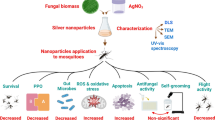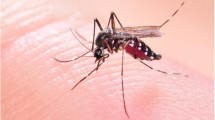Abstract
The effect of the range of temperature on the thermal adaptation in Anopheles stephensi Liston 1901 was evaluated in the laboratory. Late third instar larvae of An. stephensi were exposed to variable temperatures viz. 37°C, 39°C, 41°C, 43°C and 45°C, and their lethal time to cause 50% mortality (LTM50) values were calculated. All larvae survived up to 39°C of exposure. However, at 45°C, they died within 30 min of exposure. Pre-exposure to variable temperatures and re-exposure to higher temperatures conferred adaptive thermotolerance. The larvae pre-adapted at 41°C that were re-exposed to 43°C, and larvae pre-adapted at 39°C that were re-exposed to 45°C, were found more thermotolerant than the thermally non-adapted larvae. Adaptive cross-tolerance to malathion was also induced by pre-exposing them to 37°C and 39°C. It suggests that temperature stress also play an important role in the development of adaptive cross-tolerance to other stress conditions. Similarly, the oocyst rate was relatively more in adults that emerged from larvae pre-adapted at 40°C as compared to adults that emerged from thermally non-adapted larvae and with lower oocyst load.



Similar content being viewed by others
References
Adak T, Kaur S, Singh OP (1999) Comparative susceptibility of different members of Anopheles culicifacies complex to Plasmodium vivax. Trans R Soc Trop Med Hyg 93:573–577
Adak T, Singh OP, Das MK, Wattal S, Nanda N (2005) Comparative susceptibility of three important malaria vectors Anopheles stephensi, Anopheles fluviatilis, and Anopheles sundaicus to Plasmodium vivax. J Parasitol 91:79–82
Ansari MA, Vasudevan P, Tandon M, Razdan RK (2000) Larvicidal and mosquito repellent action of peppermint (Mentha piperita) oil. Bioresour Technol 71:267–271
Bale JS, Masters GJ, Hodkinson ID, Awmak C, Bezemer TM, Brown V, Butterfield J, Buse A, Coulson JC, Farrar J, Good JEG, Hartley R, Jones TH, Lindroth RL, Press MC, Symrnioudis I, Watt A, Whittaker JB (2002) Herbivory in global climate change research: direct effects of rising temperature on insect herbivores. Glob Chang Biol 8:1–16
Bar-Zeev M (1957) The effect of extreme temperatures on different stages of Aedes aegypti (L.). Bull Entomol Res 48:593–599
Bayoh MN, Lindsay SW (2004) Temperature-related duration of aquatic stages of the Afrotropical malaria vector mosquito Anopheles gambiae in the laboratory. Med Vet Entomol 18:174–179
Benedict MQ, Cockburn AF, Seawright JA (1991) Heat shock mortality and induced thermotolerance in larvae of the mosquito Anopheles albimanus. J Am Mosq Control Assoc 7:547–550
Bradshaw WE (1980) Thermoperiodism and the thermal environment of the pitcher plant mosquito, Wyeomiya smithii. Oecologia 46:13–17
Clements AN (1963) International series of monographs on pure and applied biology, vol 17, The physiology of mosquitoes. Pergamon Press, Oxford
Clements AN, Paterson GD (1981) The analysis of mortality and survival rates in wild populations of mosquitoes. J Appl Ecol 18:373–399
Cossins AR, Bowler K (eds) (1987) Temperature biology of animals. Chapman and Hall, New York, pp 125–157
Githeko AK, Lindsay SW, Confalonieri UE, Patz JA (2000) Climate change and vector-borne diseases: a regional analysis. Bull World Health Organ 78:1136–1146
Greever J, Georghiou GP (1979) Computer simulation of control strategies for Culex tarsalis (Diptera: Culicidae). J Med Entomol 16:180–188
Haile DG, Weidhaas DE (1977) Computer simulation of mosquito populations (Anopheles albimanus) for comparing the effectiveness of control strategies. J Med Entomol 13:553–567
Huffaker CB (1944) The temperature relations of the immature stage of the malaria mosquito An. quadrimaculatus say, with a comparison of the development power of constant and stable temperatures in insect metabolism. Ann Entomol Soc Am 37:1–27
Hurlbut HS (1973) The effects of environmental and physiological conditions of Culex tritaeniorhynchus on the pattern of transmission of Japanese encephalitis virus. J Med Entomol 10:1–12
Kay BH, Fanning ID, Mottram P (1989) Rearing temperature influences flavivirus vector competence of mosquitoes. Med Vet Entomol 3:415–422
Le Sueur D, Sharp BL (1991) Temperature-dependent variation in Anopheles merus larval head capsule width and adult wing length: implications for anopheline taxonomy. Med Vet Entomol 5:55–62
Mahmood F (1997) Life-table attributes of Anopheles albimanus (Wiedemann) under controlled laboratory conditions. J Vector Ecol 22:103–108
McDonald G, McLaren IW, Shelden GP, Smith IR (1980) The effect of temperature on the population growth potential of Culex annulirostris Skuse (Diptera: Culicidae). Austral Ecology 5:379–384
Moon TE (1976) A statistical model of the dynamics of a mosquito vector (Culex tarsalis) population. Biometrics 32:355–368
Mourya DT, Yadav P, Mishra AC (2004) Effect of temperature stress on immature stages and susceptibility of Aedes aegypti mosquitoes to Chikungunya virus. Am J Trop Med Hyg 70(4):346–350
Muirhead-Thomson RC (1940) Mosquito behaviour in relation tomalaria transmission and control in the tropics. Edward Arnold, London
Nagpal BN, Sharma VP (1995) Indian Anophelines. Oxford & IBH Publishing Co. Pvt. Ltd, New Delhi. India, p 424
Patil NS, Lole KS, Deobagkar DN (1996) Adaptive thermo tolerance and induced cross tolerance to propoxur insecticide in mosquitoes. Med Vet Entomol 10:277–282
Rae DJ (1990) Survival and development of the immature stages of Culex annulirostris (Diptera: Culicidaee) at the Ross River dam in tropical Eastern Australia. J Med Entomol 27:756–762
Rueda LM, Patel KJ, Axtell RC, Stinner RE (1990) Temperature dependent development and survival rates of Culex quinquefasciatus and Aedes aegypti (Diptera: Culicidae). J Med Entomol 27:892–898
Shelton RM (1973) The effect of temperatures on development of eight mosquito species. Mosq News 33:1–12
Swain V, Seth RK, Mohanty SS, Raghavendra K (2008) Effect of temperature on development, eclosion, longevity and survivorship of malathion-resistant and malathion-susceptible strain of Culex quinquefasciatus. Parasitol Res 103:299–303
Tammariello SP, Rinehart JP, Denlinger DL (1999) Desiccation elicits heat shock protein transcription in the flesh fly, Sarcophaga crassipalpis, but does not enhance tolerance to high or low temperatures. J Insect Physiol 45:933–938
Trpis M (1972) Development and predatory behaviour of Toxorhynchites brevipalpis (Diptera: Culicidae) in relation to temperature. Environ Entomol 1:537–546
Tun-Lin W, Burkot TR, Kay BH (2000) Effects of temperature and larval diet on development rates and survival of the dengue vector Aedes aegypti in north Queensland, Australia. Med Vet Entomol 14:31–37
Wagner VE, Tully GA, Goodman ED, Newson HD (1975) A computer simulation model for population studies of woodland pool Aedes mosquitoes. Environ Entomol 4:905–919
Watts DM, Burke DS, Harrison BA, Whitmire RE, Nisalak A (1987) Effect of temperature on the vector efficiency of Aedes aegypti for dengue 2 virus. Am J Trop Med Hyg 36:143–152
World Health Organization (1981) Instruction for determining the susceptibility or resistance of adult mosquito to organochlorine, organophosphate and carbamate insecticides establishment of base line. WHO/VBC/81.805, p 7
Worner SP (1998) Ecoclimatic assessment of potential establishment of exotic pests. J Econ Entomol 81:973–983
Acknowledgements
We acknowledge the help rendered by Mr. R. S. Sharma, Mr. Narendra Kumar of the National Institute of Malaria Research, Delhi.
Author information
Authors and Affiliations
Corresponding author
Rights and permissions
About this article
Cite this article
Raghavendra, K., Barik, T.K. & Adak, T. Development of larval thermotolerance and its impact on adult susceptibility to malathion insecticide and Plasmodium vivax infection in Anopheles stephensi . Parasitol Res 107, 1291–1297 (2010). https://doi.org/10.1007/s00436-010-2001-0
Received:
Accepted:
Published:
Issue Date:
DOI: https://doi.org/10.1007/s00436-010-2001-0




